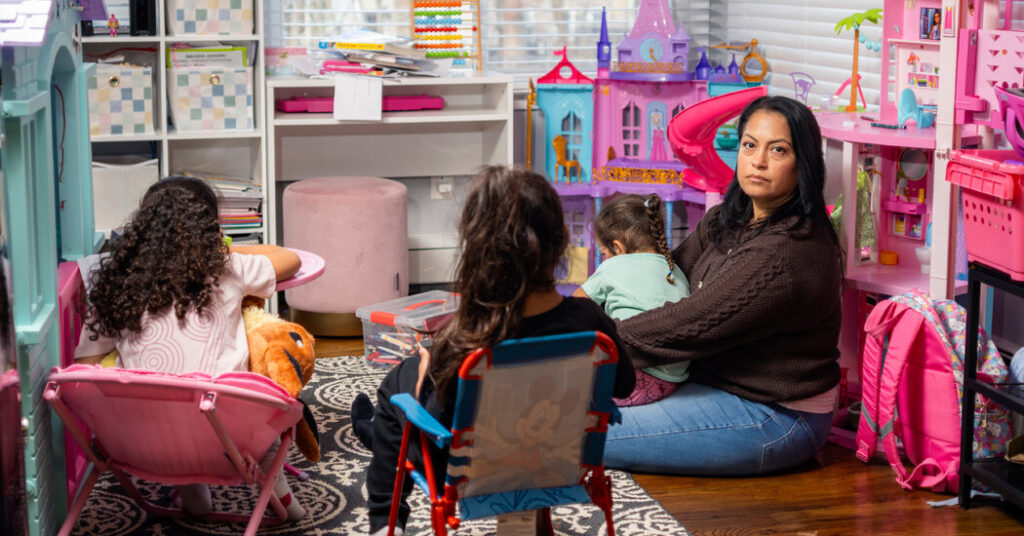In August, Jemmy Jimenez Rosa and her husband, Marcel, took their three young daughters on a vacation to Cancún, Mexico. On their return to Boston Logan airport, a Customs and Border Protection officer took Ms. Rosa aside and led her to a back room where she was told she should say goodbye to her girls. “I keep thinking this is a nightmare. Is this a nightmare? Like, is this really happening?” Ms. Rosa recalled.
Ms. Rosa was placed in a detention cell at Logan. Officers gave her virtually no information and dismissed her husband’s requests that he be allowed to bring her diabetes and anxiety medication. Ms. Rosa was born in Peru and has been a lawful permanent resident of the United States since she was 9 years old; she is now 43. Just weeks before the trip to Cancún, she had renewed her green card without incident. Her husband and her daughters are American citizens.
Over the past several months, alongside a team from Opinion Video, I’ve spoken to a half-dozen people and their families who have been taken into Immigration and Customs Enforcement detention. Each was re-entering, or was already in the country legally. No one was smuggled across the border.
None of the people we spoke to had a recent criminal record. (Three had minor nonviolent brushes with the law, all in the distant past; one received a pardon.) All were treated like suspected violent criminals, forced into tiny cells, dressed in prison uniforms, manacled for transfer. Those we spoke to were held for anywhere from 10 days to over 70 days. The experience shattered their equilibrium.
Immigration and Border Patrol officers have long held extremely broad discretionary powers to welcome or reject noncitizens arriving in the United States. And this is far from the first wave of xenophobia to hit America. But something different is happening now in the breadth and ferocity of efforts to change the makeup of this country.
The videos circulating on social media are brutal and terrifying — the often violent arrests, people pulled screaming from their cars, out of day care centers, away from their children and their spouses. What should give Americans equal pause is the inhumanity happening beyond the cameras, away from the view of judges and lawyers and the media. Due process is not a constitutional right afforded only to citizens; legal restrictions on unlawful detention apply to all people on U.S. soil.
The stories we were told call into question both the constitutionality and the morality of how the Trump administration is directing immigration policy. That immorality, once unleashed, may ultimately be aimed at others in this country, regardless of immigration status. If a woman returning from vacation with her young children can be suddenly removed from her family and her life, how can we believe that any of us will remain safe?
There was a disquieting sameness to the horror that was described to us. Those we interviewed despaired at how the detention centers were kept purposefully, horrendously cold, forcing some of them to huddle up against strangers. They spoke of lights left on 24 hours a day and of interstate transfers that came without notice. They described food that was inadequately distributed and made them unwell. Of being forced to urinate and defecate in front of fellow detainees and guards. Of being humiliated and mocked by officers. All referred to a destabilizing lack of information, the dreadful understanding that they could be held for weeks or months without anyone informing them why they were being held at all.
We heard how they begged for recourse — asked to speak with the outside world, for bond hearings, to protest their detention. They referenced, with anxiety and sorrow, others they encountered, some presumably still languishing in those cells, without counsel or relief.
Our team reviewed documentation and spoke to lawyers and family members. Some details of each account could not be independently verified, but the narratives are consistent with what they told others at the time and what they previously told the media.
During the 2024 presidential campaign, the Trump team promised the largest mass deportation in American history, a pledge to expel one million people a year, starting with violent criminals. None of the people we spoke to fit that description. All believed they had followed the rules. They renewed their green cards and showed up for regular immigration, work or visa interviews.
Then the rules seemed to change. Lawyers told us that immigration officials have always used a certain degree of their own judgment to determine if a noncitizen is a flight risk or a risk to the community. Even under President Barack Obama, whose administration ramped up deportations, law enforcement was asked to prioritize removal for people who were a significant threat and to de-emphasize those who had been living in the country lawfully.
Now people showing up for an interview with ICE about an asylum claim or a green card application, or to finalize a visa — individuals who might have once been asked to return for a court date or, in more extreme cases, given an ankle monitor — risk being taken into custody. Green card holders are discovering that decades-old interactions with law enforcement over minor marijuana charges and traffic violations are being brought forward as reasons for detention and possible expulsion. The administration is not only deterring newcomers from entering the United States; it is also effectively encouraging noncitizens who are already here to leave. This shift is seeding fear among America’s 52 million immigrants and temporary visitors, a majority of whom are here lawfully. This is a group that includes green card holders as well people holding work, student and tourist visas.
“If you want to produce the deportation numbers that the administration is after, you cannot get to those numbers if you focus solely on deporting people who have serious criminal records,” the New York University immigration professor Adam Cox told me. “There just aren’t enough people.”
Last year Mr. Cox co-wrote an article for the Just Security blog laying out paths the incoming administration might take to reach its deportation goals. They included vastly broadening the category of criminality to encompass many more people than might have been considered a community risk in the past. Being in America without a visa or entering without documentation is not a criminal offense, he wrote — it’s a civil one. But “pushing the idea that any immigrant who has violated immigration law has committed a crime” allows the administration to broadly claim that it has deported criminal elements.
Mr. Cox’s predictions appear to have borne out. Just shy of 60,000 people were held in immigration detention at the end of September, roughly a third more than the same month in 2024. The Department of Homeland Security maintains that 70 percent of immigration arrests have targeted criminals. The Migration Policy Institute and other monitoring groups have found quite the opposite: As of September, these groups found, some 71.5 percent of people held in detention had no criminal record. Of the rest, many have a record of a minor infraction, such as driving with a broken taillight.
Jasmine Mooney, a Canadian citizen, arrived at a California immigration office in early March to finalize her work visa and start a job at a U.S.-based wellness company. She has spent much of her adult life going back and forth across the border — she crossed dozens of times between 2019 and 2025 alone — though not always seamlessly: She was denied entry to work in the United States more than once, and once had a visa revoked. (These are not crimes.)
In March, when she arrived on American soil, she was told she needed to return to Canada to address a discrepancy with her visa paperwork. As she searched online for flights to Vancouver, she was approached by border agents, stripped of her bag and cellphone, and placed in a crowded holding cell. The only place to rest was on the cement floor. Ms. Mooney was able to place a phone call after 48 hours. She reached a friend, who alerted the media; later she talked to a lawyer.
Then she was transferred, in shackles, to a San Diego detention center, where she was given a prison uniform. Days later she was moved once again, also shackled, to a detention center in Arizona. There, she said, women were told to urinate into paper cups for a nurse to perform a pregnancy test. Ms. Mooney had spent her first week refusing the food, fearing it would make her ill; when she finally ate, she was sickened. She said one guard told her she might not find a path out anytime soon. “The system is meant to break you,” Ms. Mooney said.
Ms. Mooney believes the incredulous media attention around her case and her resources — she is white and a native English speaker, a former actor with friends in Los Angeles — helped speed up her case. It still took 12 terrifying days for her to be released, after which she received a five-year ban on returning to America. (In a statement to Times Opinion, the Department of Homeland Security said U.S. Customs and Border Protection arrested Ms. Mooney three times in 2024. Ms. Mooney and her lawyer said she had been previously denied entry and faced challenges to her work visa, but she was never arrested. Times Opinion reviewed documentation that supports this.)
The American immigration detention system has never been known for its humanity. Terrible conditions in detention reported during the Obama administration and the previous Trump administration — of freezing temperatures and of keeping immigrants far too long in cells meant to hold detainees no longer than 12 hours — have not improved. Now the system has been flooded with people, stalling cases, dividing families and gumming up the works of the courts. The number is set to rise: President Trump’s signature domestic policy law set aside $45 billion through September 2029 to expand the country’s detention capabilities.
The office of Senator Jon Ossoff, Democrat of Georgia, released a report in August decrying conditions in U.S. immigration detention centers. The report identified more than 500 cases of abuse and neglect, including inhumane treatment of children and pregnant women, between January and August. Mr. Ossoff’s office published a second report in October, noting cases of medical neglect and a dire lack of potable water and acceptable food.
Ms. Mooney’s lawyer, Leonard Saunders, told us that in the past, a person with her type of case — a discrepancy over work visa paperwork — would receive something called deferred inspection. This meant the person in question would be released and required to return to an immigration office with new materials supporting the visa. “They would never detain you,” he said.
Elora Mukherjee, a professor at Columbia University Law School and the director of the school’s Immigrants’ Rights Clinic, said, “The utter disregard for whether people pose any danger to the community or any flight risk is new.”
In September, the Board of Immigration Appeals, the last stop within D.H.S. for a noncitizen to challenge an immigration judge’s deportation decision, significantly limited who is eligible for bond. Under past administrations, noncitizens who were apprehended often had a means of avoiding or being released from detention, such as bond hearings or a hearing before a judge. But bond is rarely on offer now. Previously there was a path — often expensive, often difficult, but still a path — to relief and release. Now such releases are the exception.
Further, the termination of over 100 immigration judges since January has contributed to a national backlog of cases. In early November, NPR reported that dozens of those fired judges were reputed to be more sympathetic to immigrants.
Of the people we interviewed, two had no criminal histories, just a challenge to their visa statuses. Two others had over-20-year-old charges associated with possession of marijuana, both in states where marijuana is now legal. One person had a charge for personal use of a controlled substance over a decade ago. While possessing marijuana is not legal on the federal level, such one-off misdemeanor charges were once not a priority for removal. Now it seems they are.
One day after Ms. Rosa was taken into custody, her rapidly assembled legal team filed a habeas corpus petition, a legal filing protesting what they continue to call her illegal detention. Filing a federal habeas claim is complicated. It is also virtually impossible to do for tens of thousands of new detainees.
In the chaotic first several days of her detention at Logan airport, Ms. Rosa was not given the chance to shower. She was taken twice to Massachusetts General Hospital for panic attacks, the second time in shackles. Her blood pressure spiked. Like others I spoke to, she was not given a clear reason for being held. Her family came to believe it was because of a 23-year-old misdemeanor charge for possession of marijuana, for which she paid a fine at the time. (Last year Gov. Maura Healey of Massachusetts issued a blanket pardon for past charges of marijuana possession; Ms. Rosa and her lawyer, Todd Pomerleau, told us her case had been sealed in 2013 and received a full and unconditional pardon in 2024.)
But the reason for her detention was a guess. “Never once did we receive any written notice for why she was officially detained,” Mr. Pomerleau said. Border Patrol “wouldn’t answer phone calls. They wouldn’t respond to emails, written letters. It got to the point where I sent three associate attorneys to the airport after nearly four days of her detention, demanding to see her.” But, he said, “they wouldn’t even acknowledge that she was there.” (In a statement to Times Opinion, D.H.S. said that Ms. Rosa “was detained by C.B.P. at Boston Logan International Airport after her records revealed a conviction for possession of a controlled substance in 2003,” adding, “While in custody, Rosa had access to water, bathroom facilities, medicine and food.”)
After five days, Ms. Rosa was taken to a Massachusetts ICE facility to shower, and then was transferred to a rat-infested women’s jail in Maine. There, she encountered women who had been imprisoned for months. After five more terrible days, she was driven back to the first ICE facility. Then she was released — but she did not walk out to her lawyer, nor her husband. She was left outside in the rain, with no phone and no money, disheveled and frantic. She walked to a nearby mall and begged a kindly passer-by to use a phone to call her family.
Mr. Pomerleau is setting up a nonprofit aimed at scaling up the ability of like-minded lawyers to assist in habeas claims and efforts to help immigrants not only to fight to be released from detention but also to seek redress. He is quite sure the deprivation of due process will not stop with immigrants if we allow ourselves to look away.
Additional reporting by Francesca Trianni.
Sarah Wildman is a staff editor and writer in Opinion. She is the author of “Paper Love: Searching for the Girl My Grandfather Left Behind.”
The Times is committed to publishing a diversity of letters to the editor. We’d like to hear what you think about this or any of our articles. Here are some tips. And here’s our email: [email protected].
Follow the New York Times Opinion section on Facebook, Instagram, TikTok, Bluesky, WhatsApp and Threads.
The post ‘The System Is Meant to Break You’: What ICE Is Doing to People Here Legally appeared first on New York Times.




